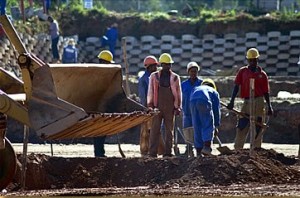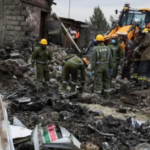SA encouraged to take advantage of Govt Infrastructure Programme
Published on April 21, 2012 at 9:56 AM by FACE OF MALAWI
South Africa have been should take advantage of government’s massive infrastructure plan with support from all sectors.
“This is a massive opportunity for the country, we need to seize it with both hands,” Deputy Director General of the Department of Trade and Industry Nimrod Zalk said on Friday.
Zalk was speaking at the last day of the Department of Economic Development’s 2nd Annual Economic Development Conference: Infrastructure and Development.
The conference, which kicked off on Thursday, discussed government’s infrastructure plan for the country as announced by Jacob Zuma in his State of the Nation Address. Representatives of state owned enterprises, government departments, the private sector and labour held various panel discussions around the plan.
Deputy President Kgalema Motlanthe earlier this month said government was ready to roll out the infrastructure plan which lists 17 strategic integrated projects that cut across rail, road, schools and hospital construction.
The projects cover a range of economic and social infrastructure across all nine provinces with emphasis on poorer regions.
Eskom CEO Brian Dames said there was a challenge around localisation as well as skills development. “It is important for us as a country to create a stable economy as well as to boost local manufacturing and growth,” said Dames.
Welcoming the infrastructure plan, Stewart Jennings, the CEO of PG Group said it was up to the private sector and government to make it work. He called for the support of localisation, adding that the manufacturing sector was struggling.
“Growth and employment is important, we need broad based growth,” he said, adding that agriculture, mining and manufacturing are the big employment creators.
Industrial Development Corporation (IDC) CEO Geoffrey Qhena said a co-ordinated approach from all stakeholders was needed to make the plan a success. If there is no co-ordination this will lead to progress not been made as it should.
He agreed that localisation was linked to infrastructure in that localisation leads to job creation as well as increases skills levels.
Co-ordination can only work if it based on trust, he said.
On the issue of infrastructure and jobs, Head of the Economic Research and Information Department of the IDC Jorge Maia said if the country could reduce dependency on imports, many jobs could be created.
As part of the infrastructure plan, investment in rail, water pipelines, energy generation and transmission infrastructure have been identified for Limpopo. The emphasis will be on coal and platinum mining for local use and export, with the region’s rail capacity expected to be extended to Mpumalanga power stations.
In KwaZulu-Natal, the plan identifies the need to strengthen the logistics and transport corridor between South Africa’s main industrial hubs, including beefing up access to Durban’s export and import facilities.
In the Western Cape, work will focus on strengthening maritime capacity in the Saldanha-Northern Cape linked region.
Energy projects will focus on supporting sustainable green energy initiatives nationally through a diverse range of clean energy options as outlined in the country’s Integrated Resource Plan (IRP) 2010. Through the IRP, it is envisaged that electricity distribution would be expanded to address historical imbalances.
On the improvement of social infrastructure, the plan notes that several new hospitals will be built while existing ones are set to be refurbished in preparation for the National Health Insurance Scheme. About 122 nursing colleges will be revamped, while 90 new schools will be built this year to replace inappropriate structures.
The Presidential Infrastructure Coordinating Commission – chaired by the President – is working on guidelines to ensure clear coordination among different provinces as they embark on various infrastructure programmes.



